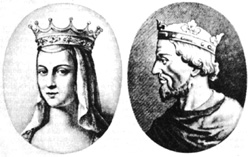ANNA, DAUGHTER OF YAROSLAV: the Mysteries of Destiny

Anna, daughter of Yaroslav the Wise, and Queen of France was one such figure of medieval Rus', even a name we have known since our schooldays. However, Anna's historical portrait holds some interesting but still virtually unknown secrets. For example, the princess's exact year of birth is still undetermined. Historical sources point to the years 1024 or 1025. But now, scholarly works more often than not refer to the year 1032.
In 1048 (1044 according to other information) Kyiv received a French embassy which brought a proposal from a widowed and childless King Henry I (reigned 1031- 1060) to marry Anna. The medieval chronicles inform us that the king heard rumors about the princess's exceptional beauty and wanted to marry her. However, things must have been much more prosaic. A complicated internal and external situation in France forced the monarch to seek influential allies, while all Europe recognized the might of Rus' in the first half of the eleventh century. Hence, we think Ukrainian historian Mykola Kotliar made a plausible suggestion that Henry I wanted primarily to rely on the military and financial potential of the old Rus' state (the most powerful then in Eastern Europe) in his struggle to unite France against the separatism of rebellious counts and barons. The latter wielded unlimited power and were de facto independent from the king. In his turn, Yaroslav the Wise must have considered this alliance useful in his confrontation with the Byzantine and Holy Roman (German) Empires.
In any case, the question of marriage was settled. Anna set off to France with a retinue. The date of church wedding is also open to debate: Scholarly research most often cites May 14, 1049, and May 19, 1051. A question arises here, about which historians are not unanimous: did the young queen adopt Catholicism or remain Orthodox? Some researchers try to prove that Anna became a Catholic, for her marriage to the French monarch would have been otherwise impossible. Other scholars believe that Henry I could have hardly demanded that his wife renounce Orthodoxy because this would have impaired the relations between Rus' and France.
The princess brought to the French capital an old Rus' Gospel ( Evangelisterium ) which was later handed over to the Reims Cathedral and became known as the Gospel of Reims. It is interesting that from that time onwards, when ascending the throne during coronation, kings swore allegiance to France exactly on this Gospel (now this priceless document is kept in the National Library of Paris).
Queen Anna had three sons: Philip the Kind-Hearted, later the king of France, Robert who died young, and Hugo the Great, later the Count of Crepy. There is a version that the couple also had a daughter Edinge whose destiny assumed a semi-legendary nature. The girl was born in 1055, and in 1074 the monarch decided to marry her off. To avoid a forced marriage, Edinge fled Paris and, tired by a long journey, stopped at a Bavarian village of Puch, on the outskirts of Munich. Local peasants gave the princess a hut where she lived until death in 1109, teaching local children and treating the sick. Edinge was buried under the altar of a church that still stands. In about 1600, the Roman Catholic Church beatified the granddaughter of Yaroslav the Wise.
After her husband's death in 1060, Anna in fact ruled for the underage King Philip I, then only seven years old. French chroniclers write that shortly before his death Henry I wanted to proclaim his wife the regent of realm, but she turned down this honor, letting Baldwin V, the Count of Flanders, become official regent. As guardian, Anna would sign together with Philip various documents which have been preserved to this day. For example, a deed she granted to the Soissons Cathedral bears her own signature in Cyrillic characters: Queen Anne. Prerevolutionary historical sources also say that Anna had another name, Agnes, in France. The Russian historian Lobanov-Rostovsky pointed out a series of French documents in which the name of Anna (Agnes) is written in Latin characters. These documents date from the times when Henry I and Philip I, Anna's husband and son, ruled.
Later on, the queen mother and her children settled at the castle of Senlis, near Paris. It is there that tumultuous events took place, adding a romantic touch to the life of the daughter of Yaroslav the Wise. Count Raoul de Crepy de Valois, one of the kingdom's most powerful warlords, fell in love with and abducted her (perhaps with her consent). Their marriage (1063) was not recognized by Pope Alexander II, and Count Raoul was even excommunicated from church. However, the lovers lived together at one of the count's castles until he died in 1074 (in 1071 according to other information).
Anna had to return to the court of Philip I. Her signature appears again on official documents next to that of her son. But now, instead of “Queen Anna,” it is “Anna, mother of King Philip.” Her name last occurred on a deed in 1075. It is not known when Anna died and where she was buried. There are many versions, one of them saying that the queen came back to Kyiv where she lived until she died in a nunnery. However, most researchers believe Anna lived her last days and was buried in France.
The kaleidoscopic life of the daughter of Yaroslav the Wise emerges before the modern reader as the plot of a medieval novel full of the magnificent unity of grandiose historical events and a personal human destiny.
Newspaper output №: Section






